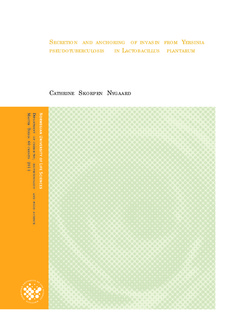| dc.description.abstract | The work conducted in this thesis is a part of a project whose main goal is to develop oral vaccines for humans with Lactobacillus as a vaccine delivery vector. Lactic acid bacteria can potentially produce therapeutic heterologous proteins and deliver them to mucosal sites. L. plantarum is an interesting candidate for this purpose because it is resistant to bile and low pH and it is a versatile bacterium with GRAS-status (generally regarded as safe). One approach that could make the bacteria a better oral vaccine is to make them target specific receptors (like β1-integrin) on the apical surface of M-cells by surface display of proteins such as invasin. This could promote transport of the bacterium by the M-cells, from the lumen of the intestine, across the epithelial barrier into organized lymphatic system below, which may promote an effective immune response. The work described in this thesis was aimed at secretion and anchoring of invasin from Yersinia pseudotuberculosis in Lactobacillus plantarum, using an inducible gene expression system formerly developed for efficient intracellular protein production.
Invasin is a membrane protein with an extracellular region that binds host cell integrin receptors and promotes uptake of the bacteria. This C-terminal extracellular region comprises five domains (referred to as Inv in this thesis), and it has been shown that the two domains (referred to as InvS) at the C-terminus comprises the shortest fragment of invasin that is capable of binding and inducing uptake. Both versions of invasin were expressed in L. plantarum WCFS1. To anchor these invasin proteins, lipo-anchors from the lipoproteins Lp_1261 and Lp_1452 from L. plantarum WCFS1 were selected. Five plasmids were constructed, pLp_1261InvS, pLp_1261Inv, pLp_1452InvS, pLp_1452Inv and pCytInv (invasin without anchor), that all were transformed into L. plantarum WCFS1. L. plantarum strains harbouring the pLp_1452InvS or pLp_1452Inv constructs showed strongly reduced growth upon induction of gene expression, whereas L. plantarum harbouring the Lp_1261-based constructs showed normal growth. All L. plantarum harbouring the different invasin constructs produced invasin, which could be detected intracellularly and for bacterial strains with an anchor, in the culture supernatant. Despite testing and optimization of various approaches to do so, it was difficult to convincingly demonstrate anchoring of invasin to the bacterial surface. However, several experiments did indicate anchoring. Experiments with Caco-2 cells did not convincingly show internalization of invasin-expressing bacteria, but clearly showed that several of the recombinant bacterial strains had increased affinity for the Caco-2 cells. In conclusion, the work described in this thesis shows that L. plantarum is able to produce, secrete, and most likely anchor invasin to the surface of the bacteria, by using lipo-anchors. The results further indicate that there is a need to optimize the anchoring strategy to make invasin more available on the surface of L. plantarum. The latter is likely to improve the ability to detect the protein as well as its in vitro functionality. | no_NO |
